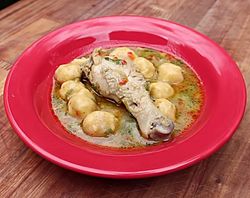Vori vori facts for kids

Chicken vorí vorí
|
|
| Type | Soup |
|---|---|
| Place of origin | Paraguay |
| Main ingredients | Corn flour, cheese, stock or broth |
Vorí vorí is a yummy, thick, yellow soup from Paraguay. It has little balls made of cornmeal, corn flour, and cheese. This special soup has roots in both the Cario-Guarani people and Sephardic traditions. It's thought to be like the matza balls eaten during Passover, but instead of wheat, it uses corn flour, which was common for the Carios.
The name "vorí vorí" comes from the Guarani language. In Guarani, repeating a word can mean there's a lot of something. So, "vorí" means one little ball, but "vorí vorí" means two or more! The word "vorí" comes from the Spanish word "bolita," which means "little ball." Since there's no 'l' sound in Guarani, "bolita" became "borita," and then it was shortened to "vorí." So, "vorí vorí" basically means "little ball, little ball."
Contents
History of Vorí Vorí
Some historians say that a German traveler named Ulrich Schmidl wrote about a starchy bread made by the Cario-Guarani people a long time ago. These native people lived near Asunción, the capital of Paraguay. Schmidl was on a Spanish ship that arrived in Asunción, and he wrote about the foods the Cario-Guarani ate.
One of their foods was called "mbujapé," which means "bread" in Guarani. To make it, they mixed corn flour or cassava starch with animal fat. Then, they wrapped it in a banana leaf and cooked it in hot ashes.
How Paraguayan Food Began
It's important to know that Paraguayan food isn't just "Guarani cuisine." It's a mix of Spanish and Cario-Guarani cooking styles. This mix happened in and around Asunción, thanks to Spanish explorers, Franciscan priests, and local people. Towns like Tobatí and Areguá still show how Paraguayan culture grew in this area.
The Cario-Guarani people were good at hunting, fishing, and growing grains. They had their own ways of cooking and special tools. When the Spanish arrived, their foods started to blend. This happened especially after 1556, when cattle were brought to Asunción. This meant new ingredients like beef, milk, eggs, and cheese became available.
So, native foods like corn, cassava, pumpkin, and sweet potato mixed with Spanish ingredients. This blend created many of the traditional Paraguayan dishes we still enjoy today, with cassava, corn, sweet corn, Paraguay cheese, milk, and beef as main ingredients.
Ingredients and Preparation
Making vorí vorí is quite simple!
What You Need
- Corn flour
- Fresh cheese
- Fatty broth or stock
- Water
How to Make It
1. First, put the corn flour and crumbled cheese into a bowl. 2. Slowly add the fatty broth to this mixture. Mix it until you can easily roll it into small balls with your hands. 3. Each "vorí" (little ball) should be about the size of a large grape. 4. Once you have enough little balls, carefully drop them into boiling soup. 5. Let them cook for about 5 minutes. 6. If the soup becomes too thick, you can add a bit more boiling water to thin it out.
Interesting Facts About Vorí Vorí
- The traditional vorí vorí is also known as "vorí vorí caldo."
- One popular way to make it is "vorí vorí de gallina." This version adds pieces of chicken that have been grilled in their own fat to the soup.
- If the little balls are made extra small, they are sometimes called "tu'i rupi'a." This is a Guarani phrase that means "parakeet eggs"!
- Vorí vorí is one of the few Paraguayan dishes that everyone enjoys, no matter how rich or poor they are. You can find it at fancy parties and on simple tables in country homes.
- After the Paraguayan War (a big war from 1864 to 1870 against Argentina, Brazil, and Uruguay), food was hard to find in Paraguay. Because of this, many traditional Paraguayan dishes, including vorí vorí, are very rich in calories and protein. This helped people get enough energy and nutrients when food was scarce.
See also
 In Spanish: Vorí vorí para niños
In Spanish: Vorí vorí para niños

